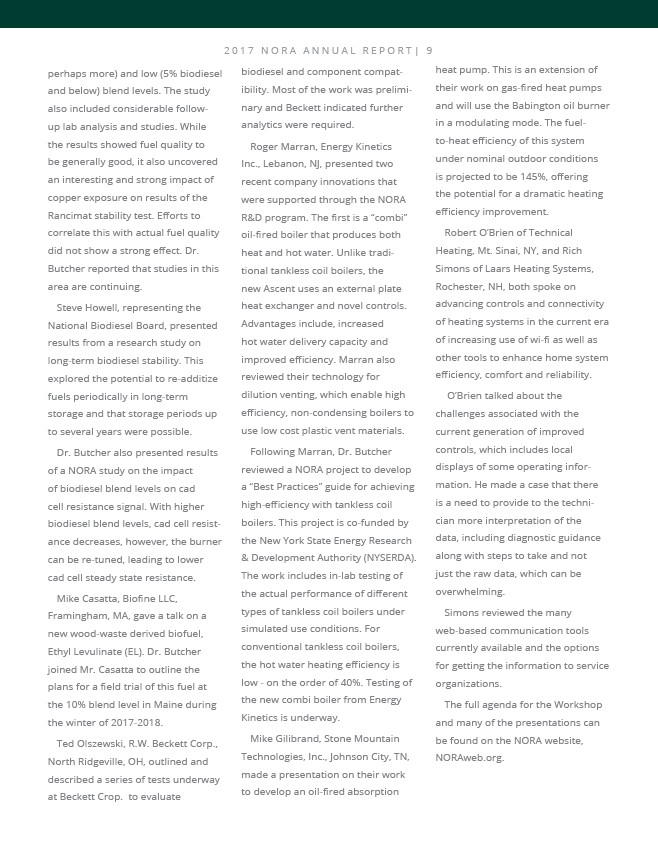
perhaps more) and low (5% biodiesel
and below) blend levels. The study
also included considerable followup
lab analysis and studies. While
the results showed fuel quality to
be generally good, it also uncovered
an interesting and strong impact of
copper exposure on results of the
Rancimat stability test. Efforts to
correlate this with actual fuel quality
did not show a strong effect. Dr.
Butcher reported that studies in this
area are continuing.
Steve Howell, representing the
National Biodiesel Board, presented
results from a research study on
long-term biodiesel stability. This
explored the potential to re-additize
fuels periodically in long-term
storage and that storage periods up
to several years were possible.
Dr. Butcher also presented results
of a NORA study on the impact
of biodiesel blend levels on cad
cell resistance signal. With higher
biodiesel blend levels, cad cell resistance
decreases, however, the burner
can be re-tuned, leading to lower
cad cell steady state resistance.
Mike Casatta, Biofine LLC,
Framingham, MA, gave a talk on a
new wood-waste derived biofuel,
Ethyl Levulinate (EL). Dr. Butcher
joined Mr. Casatta to outline the
plans for a field trial of this fuel at
the 10% blend level in Maine during
the winter of 2017-2018.
Ted Olszewski, R.W. Beckett Corp.,
North Ridgeville, OH, outlined and
described a series of tests underway
at Beckett Crop. to evaluate
biodiesel and component compatibility.
Most of the work was preliminary
and Beckett indicated further
analytics were required.
Roger Marran, Energy Kinetics
Inc., Lebanon, NJ, presented two
recent company innovations that
were supported through the NORA
R&D program. The first is a “combi”
oil-fired boiler that produces both
heat and hot water. Unlike traditional
tankless coil boilers, the
new Ascent uses an external plate
heat exchanger and novel controls.
Advantages include, increased
hot water delivery capacity and
improved efficiency. Marran also
reviewed their technology for
dilution venting, which enable high
efficiency, non-condensing boilers to
use low cost plastic vent materials.
Following Marran, Dr. Butcher
reviewed a NORA project to develop
a “Best Practices” guide for achieving
high-efficiency with tankless coil
boilers. This project is co-funded by
the New York State Energy Research
& Development Authority (NYSERDA).
The work includes in-lab testing of
the actual performance of different
types of tankless coil boilers under
simulated use conditions. For
conventional tankless coil boilers,
the hot water heating efficiency is
low - on the order of 40%. Testing of
the new combi boiler from Energy
Kinetics is underway.
Mike Gilibrand, Stone Mountain
Technologies, Inc., Johnson City, TN,
made a presentation on their work
to develop an oil-fired absorption
heat pump. This is an extension of
their work on gas-fired heat pumps
and will use the Babington oil burner
in a modulating mode. The fuelto
heat efficiency of this system
under nominal outdoor conditions
is projected to be 145%, offering
the potential for a dramatic heating
efficiency improvement.
Robert O’Brien of Technical
Heating, Mt. Sinai, NY, and Rich
Simons of Laars Heating Systems,
Rochester, NH, both spoke on
advancing controls and connectivity
of heating systems in the current era
of increasing use of wi-fi as well as
other tools to enhance home system
efficiency, comfort and reliability.
O’Brien talked about the
challenges associated with the
current generation of improved
controls, which includes local
displays of some operating information.
He made a case that there
is a need to provide to the technician
more interpretation of the
data, including diagnostic guidance
along with steps to take and not
just the raw data, which can be
overwhelming.
Simons reviewed the many
web-based communication tools
currently available and the options
for getting the information to service
organizations.
The full agenda for the Workshop
and many of the presentations can
be found on the NORA website,
NORAweb.org.
2 0 1 7 N O R A A N N U A L R E P O R T | 98